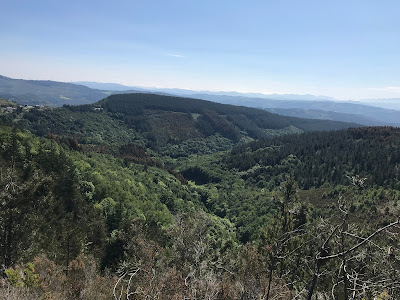Postcard 3 From The Camino
by mr mike, June 2023
After about 15 days, the Camino del Norte
divided.

One spur continues
along the coast as the Camino del Norte; the other spur turned inland and
became the Camino Primitivo. “Primitivo”
in this context means “the first” as it was the first recognised Camino to
Santiago centuries ago. Relatively few pilgrims walk the Primitivo.

Out of 31 days total walking it was not until
about day 26 that a relatively flat stage arrived. As a measure of the
difficulty, on a flattish stage I average 5kms/hour whereas on the Primitivo I
was averaging 3.5-4 kms/hour – which led to some long (8 hour plus) days.
But one advantage of moving inland was that
the effect of the Atlantic on the weather diminished. It was a little warmer and drier (although I
was lucky to have only 3 days of rain in the first two weeks).
The
high point (literally) of the Primitivo is crossing a series of mountain
peaks. The Pilgrim has two options: option one is a shorter route that takes one
day; there is a longer two-day route.
Both routes involve climbing the highest peak at the end. I was trying to make
my mind up having dinner at the albergue in Campiello which way to go next
day. It was Saturday evening. Luckily a
Spanish woman told me that one of the albergues at the conclusion of this stage
was closed on Sunday (closures on “domingo” are common for shops/bars etc in
rural Spain). So, I decided on the two-day route meaning I would reach the
destination on Monday. Fortunately, earlier on after Bilbao I had gained a day
in hand doing two stages in one day (just over 40kms).
So, on Sunday I walked to Pola de Allande.
I learned there that the peaks had been blanketed in heavy mist and it had
rained that day. (Pilgrims are warned that the short route is too dangerous in
bad weather).
On Monday morning I set off to climb the
Alto de Palo. The weather had cleared
and it was blue sky and sunny in the foothills


The climb
to the top took about 2.5 hours. The climb became progressively steeper,
approaching 45 degrees near the top. But
it was worth it; the views were magnificent – like being on top of the world

at the peak with yours truly in shadow; incidentally, the yellow
cockleshell motif is the symbol of the Camino.

The other side.
After sweating profusely on the way up,
there was an icy wind at the top, so time only to let the view sink in and take
a few pictures before descending.

Not only is the descent steep, but
the paths are quite rugged with loose rock and stone making walking difficult. It would be quite easy to slip (and carrying
a backpack can easily put you off balance) and a fall, or twisted ankle or
worse would have caused a world of trouble.
One particularly long descent (approx 5kms) down to a long reservoir
One particularly long descent (approx 5kms) down to a long reservoir

was generally agreed to be the most
difficult. The way over the reservoir
was across a rather dramatic dam


with the inevitable
climb up on the other side.
Gradually, the hills became a little
smaller

and after a pleasant night in the old city of Lugo, the
terrain began to flatten out

Eventually, a signpost showing less than 50kms to Santiago.

After arriving in Santiago, and collecting
my Compostella I had a wander around the cathedral and the old part of the
town. I happened upon a few familiar faces I had seen from time to time during the
journey and we bid a rather emotional farewell.


7 comments:
Very well done, Mr Mike. It’s not the kind of challenge I’m capable of anymore so good on ya.
Second that. Nicely done. Sydney to Melbourne next up?
cheers
v./
Thank you, mr mike, for providing your postcards and photos - truly impressive. Did you get to the Pilgrim's Service in the Cathedral?
Thank you gents.
No Mrs I, sadly I didn't go to the Pilgrim Service. I left for Madrid late afternoon the day I arrived Santiago, and departed from Madrid early the following morning. This was because flight options to Sydney (even booking 5 months prior) were looking limited. In hindsight, it is something I do regret.
Just a few days back, and I'm feeling very low. Its a mixture of jet lag, physical tiredness, and a strange feeling of grieving or regret that a chapter of my life has closed.
Sorry to hear it, mr mike - and you've flown back to winter, which won't help, although it can't be anywhere near as dreadful as an Orkney winter. The Camino chapter has closed - but the next chapter could include the Orkney St Magnus Pilgrim Way, although it is only 58 miles, unlike the 200 miles you've just walked, or the 63 mile St Cuthbert's Pilgrim Way in Northumberland. Both routes follow the path that the saints' bodies were carried en route to their final resting place. In St Magnus' case, that is his Cathedral, where his bones are walled up in a pillar.
Sorry, mr mike, I've totally short-changed you - I'm just useless at these Napoleonic measurements, still in Imperial, me. Not 200 miles at all - 559 miles, if the Google-machine is correct. That is some achievement, just on a physical level. I'd love to read your thoughts about the spiritual impact that such a journey had on you.
Well done, mr mike. The down will soon turn itself into an of a reflection upon a trial endured and overcome.
Post a Comment